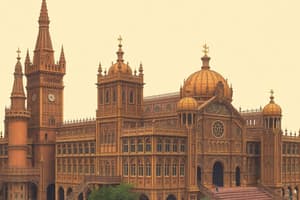Podcast
Questions and Answers
Which of the following scenarios best illustrates the concept of opportunity cost?
Which of the following scenarios best illustrates the concept of opportunity cost?
- A student chooses to attend a concert instead of working at their part-time job. (correct)
- A consumer purchases a product during a sale, taking advantage of a lower price.
- A business expands its operations to a new geographical market.
- A company decides to invest in new machinery to increase production efficiency.
Which of the following statements is an example of normative economic analysis?
Which of the following statements is an example of normative economic analysis?
- Increased government spending leads to higher inflation rates.
- Higher taxes on corporations lead to decreased profits and investment.
- A decrease in interest rates encourages more borrowing and investment.
- The government should increase the minimum wage to reduce income inequality. (correct)
In a purely market-based economy, how are key economic questions primarily answered?
In a purely market-based economy, how are key economic questions primarily answered?
- Through the interaction of individual consumers and firms in markets. (correct)
- By historical precedent and traditional methods of production.
- By a central planning committee that dictates production and distribution.
- Through a combination of government regulations and market forces.
What does the economic concept of ceteris paribus allow economists to do?
What does the economic concept of ceteris paribus allow economists to do?
An outward shift in a country's Production Possibilities Frontier (PPF) represents:
An outward shift in a country's Production Possibilities Frontier (PPF) represents:
If Country A can produce 10 units of good X or 20 units of good Y with one unit of input, while Country B can produce 15 units of good X or 5 units of good Y with one unit of input, which country has the comparative advantage in producing good X?
If Country A can produce 10 units of good X or 20 units of good Y with one unit of input, while Country B can produce 15 units of good X or 5 units of good Y with one unit of input, which country has the comparative advantage in producing good X?
According to the law of demand, an increase in the price of a good will:
According to the law of demand, an increase in the price of a good will:
Which of the following factors would cause a shift in the demand curve for coffee?
Which of the following factors would cause a shift in the demand curve for coffee?
Assuming that pens and pencils are substitutes, an increase in the price of pens will likely cause:
Assuming that pens and pencils are substitutes, an increase in the price of pens will likely cause:
What is the likely effect of imposing a price ceiling below the equilibrium price in a market?
What is the likely effect of imposing a price ceiling below the equilibrium price in a market?
Consumer surplus is represented by the area:
Consumer surplus is represented by the area:
Which of the following is an example of applying marginal thinking in economics?
Which of the following is an example of applying marginal thinking in economics?
What is the primary role of prices in a well-functioning market economy?
What is the primary role of prices in a well-functioning market economy?
A binding price floor is set above the equilibrium price. What is its most likely effect?
A binding price floor is set above the equilibrium price. What is its most likely effect?
What is the formula for calculating profit?
What is the formula for calculating profit?
Which of the following scenarios creates a deadweight loss?
Which of the following scenarios creates a deadweight loss?
How does an increase in income typically affect the demand curve for a normal good?
How does an increase in income typically affect the demand curve for a normal good?
What is the primary distinction between absolute advantage and comparative advantage?
What is the primary distinction between absolute advantage and comparative advantage?
What is the effect on equilibrium price and quantity when there is a simultaneous increase in both supply and demand?
What is the effect on equilibrium price and quantity when there is a simultaneous increase in both supply and demand?
Which of the following best describes 'rational behavior' from an economist's perspective?
Which of the following best describes 'rational behavior' from an economist's perspective?
Flashcards
Economics
Economics
The study of how individuals and societies allocate limited resources to satisfy unlimited wants.
Scarcity and Choice
Scarcity and Choice
Limited resources require choices and trade-offs.
Opportunity Cost
Opportunity Cost
The value of the next best alternative forgone when making a decision.
Economic Models
Economic Models
Signup and view all the flashcards
Positive Analysis
Positive Analysis
Signup and view all the flashcards
Normative Analysis
Normative Analysis
Signup and view all the flashcards
Microeconomics
Microeconomics
Signup and view all the flashcards
Macroeconomics
Macroeconomics
Signup and view all the flashcards
Ceteris Paribus
Ceteris Paribus
Signup and view all the flashcards
Market Economy
Market Economy
Signup and view all the flashcards
Command Economy
Command Economy
Signup and view all the flashcards
Scientific Method in Economics
Scientific Method in Economics
Signup and view all the flashcards
Circular Flow Diagram
Circular Flow Diagram
Signup and view all the flashcards
Land
Land
Signup and view all the flashcards
Labor
Labor
Signup and view all the flashcards
Capital
Capital
Signup and view all the flashcards
Entrepreneurship
Entrepreneurship
Signup and view all the flashcards
PPF (Production Possibilities Frontier)
PPF (Production Possibilities Frontier)
Signup and view all the flashcards
Comparative Advantage
Comparative Advantage
Signup and view all the flashcards
Consumer Surplus
Consumer Surplus
Signup and view all the flashcards
Study Notes
- The test is on Thursday, February 27, 2025, at 8 PM in 100 Thomas and covers chapters 1-4 (excluding appendix to Chapter 4 and taxes) + "Thinking Like an Economist"
Chapter 1: Economics: Foundations and Models
- Economics studies how individuals and societies allocate limited resources to satisfy unlimited wants.
- Resources like land, labor, and capital are limited which necessitates choices and trade-offs.
- Opportunity Cost: The value of the next best alternative given up when making a decision.
- Economic models are simplified representations of reality used to analyze complex economic activities.
- Positive analysis is descriptive and fact-based. Example: "Unemployment rate is 5%".
- Normative analysis is opinion-based and prescriptive. Example: "Government should reduce unemployment".
- Microeconomics focuses on individual markets, firms, and consumer behavior.
- Macroeconomics deals with aggregate economic issues like inflation and GDP.
- Ceteris Paribus: Latin for "all else equal," used to isolate the impact of one change in economic analysis.
- Three Fundamental Questions:
- What to produce?
- How to produce?
- For whom to produce?
- Market economy: Individuals and businesses decide what to make, sell, and buy based on supply and demand, with the government having little control
- Command economy: the government makes all economic decisions, like what goods to produce, how much they cost, and who gets them.
Thinking Like an Economist
- Scientific Method: Economists formulate hypotheses, test them with data, and refine theories.
- Economic Assumptions: simplify real-world complexities for better analysis.
- I, Pencil: A lesson on spontaneous order and the invisible hand in markets.
- Circular Flow Diagram: Illustrates the movement of money, goods, and services between households and firms.
- Circular Flow Model:
- Households spend money in markets for goods and services, which generates revenue for firms.
- Firms then use this revenue to pay wages, rent, and profits to households in markets for factors of production, which provides income to households.
Chapter 2: Trade-offs, Comparative Advantage, and the Market System
-
Four Types of Resources:
- Land (Natural resources)
- Labor (Human effort)
- Capital (Machines, tools, buildings)
- Entrepreneurship (Risk-taking, innovation)
-
PPF (Production Possibilities Frontier):
- Shows the maximum output combinations of two goods.
- Points inside the curve = inefficient, on the curve = efficient, outside the curve = unattainable.
-
PPF Shifts:
- Outward shift = economic growth (e.g., better technology).
- Inward shift = resource depletion (e.g., war, natural disaster).
-
Absolute Advantage: Ability to produce more of a good with the same resources.
-
Comparative Advantage: Ability to produce a good at a lower opportunity cost, this is the basis for trade.
-
Consuming outside of the PPC is achieved through specialization and trade.
Chapter 3: Demand & Supply
- Law of Demand: Price ↑ leads to Quantity Demanded ↓ (Inverse Relationship).
- Law of Supply: Price ↑ leads to Quantity Supplied ↑ (Direct Relationship).
- Equilibrium: Market-clearing price where Qd (quantity demanded) = Qs (quantity supplied).
- Demand curve shifters: Income, tastes, substitutes, complements, expectations, number of buyers.
- Supply curve shifters: Input prices, technology, expectations, number of sellers.
- Simultaneous Shifts: Can make price or quantity changes ambiguous.
- Substitutes: Price of one good ↑, Demand for the other good ↑.
- Complements: Price of one good ↑, Demand for the other good ↓.
- Price ↑ leads to movement along the curve (Change in Quantity Demanded or Supplied).
- A shift to the Right of the curve illustrates an increase in Demand/Supply.
- A shift to the Left of the curve illustrates a decrease in Demand/Supply.
Chapter 4: Efficiency & Price Controls
- Prices allocate resources efficiently in competitive markets.
- Consumer Surplus: Difference between willingness to pay and actual price.
- Producer Surplus: Difference between price received and minimum acceptable price.
- Price Ceilings: Maximum legal price, which causes shortages. (e.g., Rent Control)
- Price Floors: Minimum legal price, which causes surpluses. (e.g., Minimum Wage)
- Consumer surplus is at the top (above equilibrium price)
- Producer surplus is at the bottom (below equilibrium price).
- Deadweight Loss: the loss of total surplus (consumer + producer surplus) that happens when a market is not operating efficiently
- Taxes – A sales tax increases the price for buyers and reduces what sellers receive, leading to fewer transactions.
- Price Ceilings (like rent control) – If rent is set too low, landlords may rent out fewer apartments, creating a shortage.
- Price Floors (like minimum wage) – If wages are set too high, some employers may hire fewer workers, causing unemployment..
Practice Questions & Answers
- A good is scarce if there is not enough of it available to satisfy all human wants at a zero price.
- Opportunity cost is the value of the next best alternative foregone when making a decision.
- Example: If producing 1 unit of coffee means giving up 2 units of nuts, the opportunity cost of 1 coffee = 2 nuts.
- An incentive is something that motivates behavior.
- Examples: Bonuses for workers, tax breaks for businesses, fines for speeding.
- Demand Increase: Price ↑, Quantity ↑
- Supply Increase: Price ↓, Quantity ↑
- Simultaneous shifts: Depends on magnitude of changes.
- Price ceiling below equilibrium generates a shortage and black markets.
- Price floor above equilibrium generates a surplus and wasted resources.
- Profit = Total Revenue - Total Cost; Firms have costs such as wages, rent, and materials.
- 8 of the 10 key concepts from "Thinking Like an Economist." are:
- Opportunity Cost
- Marginal Thinking
- Incentives
- Trade
- Markets
- Property Rights
- Rational Behavior
- Competition
Studying That Suits You
Use AI to generate personalized quizzes and flashcards to suit your learning preferences.




